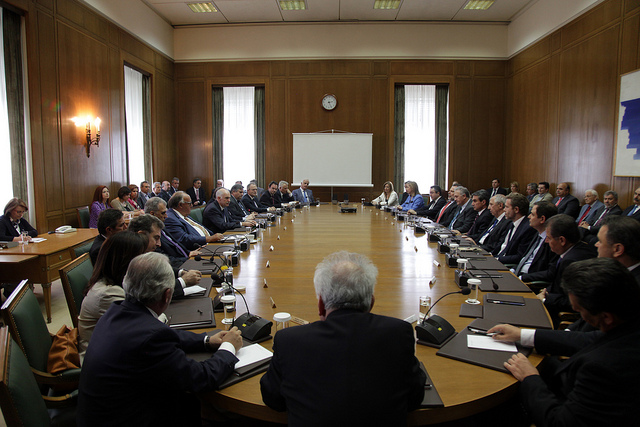A number of factors determine Cabinet size, while Cabinet size itself affects public spending levels and policy outcomes
As Democratic Audit research has shown, the size of British Cabinet has grown exponentially in recent years. But does this itself have any impact on policy? Indridi H. Indridason presents evidence that it does, particularly in terms of public spending levels, and shows that cabinet size relates more generally to the size of the Government overall. Meanwhile, a number of factors, including political expediency, the growth of Coalition government, and the need to maintain party discipline all influence cabinet size.

Bigger Cabinets spend more, according to new research (Credit: Αντώνης Σαμαράς Πρωθυπουργός της Ελλάδας, Credit: CC by SA 2.0)
The size of government cabinets has been shown to affect government finances – a greater number of cabinet ministers is correlated with, e.g., governments spending, larger deficits, revenues, transfers, government wage consumption, and labor tax share. The theoretical argument is typically that individual ministers gain from spending in their portfolio – whether because of their policy preferences or because greater levels of spending signal quality or competence – whereas the political cost are borne by the cabinet as a whole. Thus, as the cabinet grows larger the individual minister bears a smaller cost as the responsibility for government spending or deficits is divided among more ministers.
But why are some cabinets small while others are large? Journalistic accounts tend to cite political expedience – party leaders owe supporters favors or that certain politicians must be brought into the cabinet to satisfy party factions, whether based on ideology, geography, race, etc. Such accounts also often suggest that cabinets have become ‘too big’ without really clearly explaining why large cabinets are problematic – although the implicit assumption often seems to be that large cabinets may be more difficult to manage or simply that they waste public resources by paying more ministerial salaries than is necessary.
In an article published in the European Journal of Political Research Shaun Bowler and I took a closer look at the determinants of cabinet size. We argue that the number of ministerial appointments is driven, at least in part, by political circumstances. The first of these comes into play at the formation of a coalition government. In order to form a government, the coalition parties must solve two related problems; what the coalition’s policy should be and how to divide up the government portfolios. The latter is, of course, seen as important among politicians and parties – apart from conferring a certain status on a politician heading a portfolio is usually seen as conferring significant advantages in terms of policy formulation. Portfolios tend to be allocated roughly proportional to the government parties’ legislative strength.
Achieving proportionality, however, is difficult in small cabinets. Consider, for example, a coalition of two equally sized parties bargaining over three portfolios. In this case there is no way for one of the parties to avoid being twice as well represented in the cabinet as the other one. The problem can, however, be solved by adding a portfolio. As the number of coalition partners increases it becomes more difficult to achieve a proportional outcome and, other things equal, the temptation to enlarge the cabinet becomes stronger.
The second political consideration for cabinet parties is that they need to be able to deliver support for government legislation – which will, at least some of the time, diverge from their MPs’ preferred policy positions whether because the parties lack cohesion or because government bills are the result of a compromise between parties. Thus, cabinet parties will from time to time rely on party discipline and one of the most important tools in the cabinet’s arsenal is its influence over the MPs careers – in particular, who gets promoted to the cabinet. A ministerial post can only be effective as a carrot if attaining a post is both feasible and if such a post is considered valuable.
Increasing the size of the cabinet improves a MP’s prospect of promotion but, at the same time, reduces the value of being a minister – as the number of posts goes up, the number of issues falling under a given portfolio must go down and, similarly, the prestige of the position can be assumed to go down the less exclusive cabinet membership is. Thus, for a legislature of a given size there is an optimal cabinet size in terms of maximizing party discipline and there should be a positive relationship between legislature size and cabinet size.
Finally, if cabinet size has consequences for government budgeting and finances, government parties may differ in terms of their preference for cabinet size. In particular, parties on the right of the political spectrum that favor a smaller state should favor smaller cabinets as smaller cabinets have been associated with less government spending and lower deficits.
To subject these hypotheses to a test we examine cabinet size in 17 West-European parliamentary democracies over about 60 year time period (1944-2005). We control for several alternative explanations of cabinet size. For example, politics in larger, more populous countries may be more complicated, warranting more specialized departments. Moreover, it has been observed that there is a relationship between population and legislature size (the cube root law) – not controlling for populations size would then introduce a risk of observing a spurious relationship between legislature and cabinet size. For similar reasons we control for the time (year). Governments have over time taken on a greater number of responsibilities and the size of government has grown over time. We also control for political factors such as EU membership and federalism, which may call for additional government departments.
Our findings are generally in line with our theoretical expectations. Cabinets are larger where and when government coalitions include many parties – each additional coalition party increases the size of the cabinet by about one minister. Cabinets in countries that have larger legislatures have more cabinet ministers although the effect tapers off once legislature size reaches about 500 MPs. Legislature size is, of course, largely constant within countries but there are indications in seven of the nine countries that have experienced change in legislature size that cabinet size increased as well. Finally, we find that conservative cabinets tend to be smaller than both socialist and centrist cabinets (while there is generally not a difference between socialist and centrist cabinets).
In sum, we find evidence that the number of cabinet ministers is influenced by strategic calculations on behalf of the cabinet parties. The literature on parliamentary governments generally treats the number of ministers as being exogenously given while journalistic accounts tend to emphasize cabinet posts as currency for buying of various factions that can threaten the government or its agenda. While there is probably some truth to both accounts our findings suggest there is a more complex story where cabinet size is affected by factors related to the formation of government coalitions, by the coalition’s need to maintain party discipline, and anticipation of the fiscal consequences of meddling with the size of the cabinet.
—
Note: this post represents the views of the author, and not those of Democratic Audit or the LSE. it is based on this article from the European Journal of Political Research. Please read our comments policy before posting. The shortenened URL for this post is: https://buff.ly/1fvYcdf
—
 Indridi H. Indridason is Associate Professor at University of California, Riverside. For more information on Indridi H. Indridason’s research see his website.
Indridi H. Indridason is Associate Professor at University of California, Riverside. For more information on Indridi H. Indridason’s research see his website.





 Democratic Audit's core funding is provided by the Joseph Rowntree Charitable Trust. Additional funding is provided by the London School of Economics.
Democratic Audit's core funding is provided by the Joseph Rowntree Charitable Trust. Additional funding is provided by the London School of Economics.
… [Trackback]
[…] Read More: democraticaudit.com/?p=4868 […]
Bigger Cabinet, bigger Government? https://t.co/9CbKF95CGq
Various factors determine Cabinet size, while Cabinet size itself effects public spending levels & policy outcomes https://t.co/nrIFFHTvoI
Several factors set Cabinet size, and then Cabinet size itself effects public spending levels and policy outcomes https://t.co/IQtisLB50y
A number of factors determine Cabinet size, while Cabinet size itself effects public spending levels and… https://t.co/8lfxzHHand
perché crescono le dimensioni del governo in UK e quali sono conseguenze di questo ampliamento @democraticaudit https://t.co/dubVFKoLS5